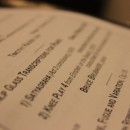[Article first published as On Minimalism: Repetition and Change on Blogcritics.]
Minimalism — Dictionary.com defines the movement as “a reductive style or school of modern music utilizing only simple sonorities, rhythms, and patterns, with minimal embellishment or orchestrational complexity, and characterized by protracted repetition of figurations, obsessive structural rigor, and often a pulsing, hypnotic effect.”
 Two years ago, I wrote a blog post about the experience of hearing Philip Glass’s “Mad Rush” at a concert, and noted back then that this was music that could be extremely beautiful both in its attractive textures, consonance, and hypnotism. On the other hand, I found it an extremely limited musical language. Lately, I’ve been thinking again about the appeal of minimalism, especially as I program John Corigliano’s “Fantasia on an Ostinato” for some upcoming concerts.
Two years ago, I wrote a blog post about the experience of hearing Philip Glass’s “Mad Rush” at a concert, and noted back then that this was music that could be extremely beautiful both in its attractive textures, consonance, and hypnotism. On the other hand, I found it an extremely limited musical language. Lately, I’ve been thinking again about the appeal of minimalism, especially as I program John Corigliano’s “Fantasia on an Ostinato” for some upcoming concerts.
In trying to explain the rise of minimalism, Kyle Gann wrote that minimalism was an expected return to simpler forms after serialism, or music both extremely difficult to compose and hear, had run its course. But while serialism may be an extremely difficult listening experience, and a disorienting one at that, minimalism poses its own challenges to the listener even with all its seeming tonality. John Corigliano, who dabbled in minimalistic techniques in his 1985 piano composition “Fantasia on an Ostinato,” wrote,
I approached this task with mixed feelings about the contemporary phenomenon known as minimalism, for while I admire its emphasis on attractive textures and its occasional ability to achieve a hypnotic quality (not unlike some late Beethoven), I do not care for its excessive repetition, its lack of architecture and its overall emotional sterility.

